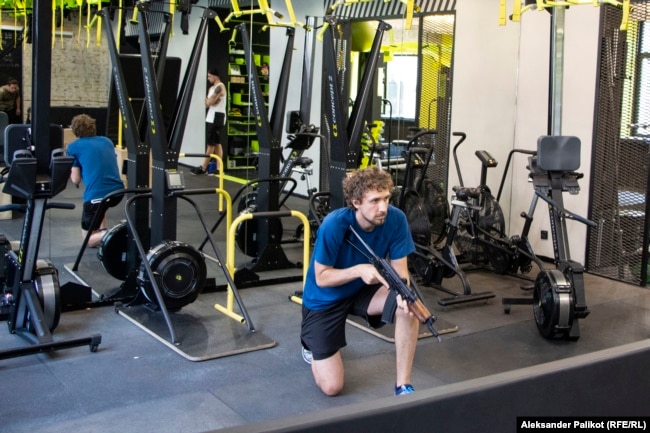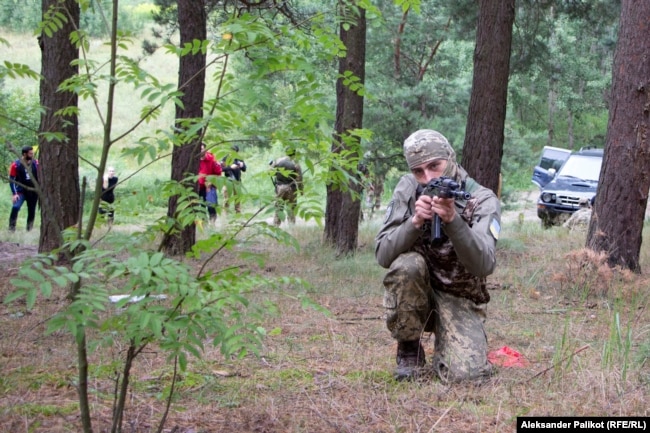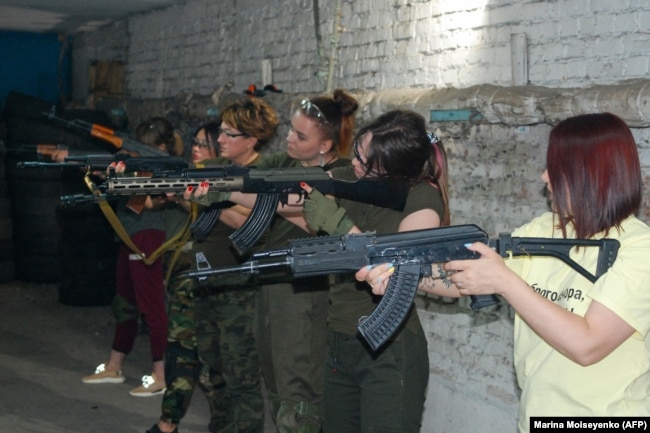In addition to pilates and elliptical machines, Lululemon-clad gym members practice weapons handling and basic drone operation. JL
Aleksander Palikot reports in RFE/RL:
In Kyiv right now, no fewer than 10 organizations offer basic military training to civilians. These days, the men and women in bright, modern sports club exercise rooms may be wearing bulletproof vests over their sweats and holding machine guns: they host combat courses for civilians, which are in demand in Ukraine's capital as war rages to the south and east nearly six months after Russia launched a large-scale invasion on February 24. Intensive two-day outdoor workshops involve camping, physical exercise, handling weapons, and operating a drone."Grenade!"
As recently as last year, the shout would have been frighteningly out of place at Kyiv's EBSH sports club -- a gym like those in well-heeled neighborhoods worldwide, frequented by upwardly mobile members seeking to get fit, build muscle, or lose weight, and perhaps get their weekly dose of adrenaline.
These days, the men and women in its bright, modern exercise room may be wearing bulletproof vests over their sweats and holding machine guns: EBSH hosts combat courses for civilians, which are in demand in Ukraine's capital as war rages to the south and east nearly six months after Russia launched a large-scale invasion on February 24.
The warning cry from Andriy Shevtsov, a 35-year-old IT specialist, came on the final day of a crash course in tactical training, one of many programs like it in Kyiv. As his classmates hit the deck, hands covering their ears, a pink training grenade slowly rolled across the floor and then stopped -- and everybody burst out laughing.
The group of 12 was practicing handling assault rifles, approaching the enemy with covering fire, and staunching bullet wounds. Over three weeks, they had met 14 times for tactical and physical training, outdoor activities, and for a combat-medicine workshop.
"The course is designed for absolute beginners," said Kyrylo Kurinniy, the group's instructor.
"In 2014, I was exactly in their situation: I had never even carried a weapon in my hands," he added, referring to the year the war between Moscow-backed forces and the government broke out in the Donbas -- the Donetsk and Luhansk regions of eastern Ukraine, where Moscow had fomented separatism after seizing control of Crimea, further southwest.
Around that time, he joined the paramilitary group Right Sector, he said. And this February, he joined a territorial defense unit in Kyiv -- one of many created nationwide as Russia massed its forces at the border in the months before the invasion.
It's difficult to say how many training courses like the one Kurinniy was leading are on offer in Kyiv right now, but no fewer than 10 organizations offer basic military training to civilians. Ordinary Ukrainians were already rushing to such programs early last winter, when the threat of Russian invasion was looming large.
At the time, many Western experts were predicting Kyiv's rapid defeat -- something Russian President Vladimir Putin clearly expected -- followed by a decentralized guerrilla war against the occupying forces. That did not happen, and the Russian forces that threatened the capital in the first weeks after the invasion retreated months ago -- but fighting is heavy in the Donbas and southern Ukraine, and the demand for combat training has not faded.
'This War Is A Marathon'
"The war forced me out of my native Donetsk years ago," Shevtsov said, "but it wasn't until February 24 that my rose-colored glasses fell off. Only then did I understand that one cannot escape war with Russia."
He did not leave Kyiv after the invasion and started to volunteer for the Ukrainian IT Army -- a network that supports the war effort online. Now he is set on continuing what he calls "paramilitary self-education."
Like most of the course participants at EBSH, Shevtsov had no prior military training. Some men from the group said they believe they may be drafted and want to get as much preparation as possible.
Stanislav Tyhonko, a 25-year-old business consultant, says that half of his friends are on the front lines. Shortly after the February invasion, he went to a recruitment office but was rejected for lack of military training. Now, in addition to attending the training sessions, he is acquiring military equipment and applying for a gun permit.
"Even if I don't get enlisted tomorrow, I want to be ready for the possibility of street fighting," Tyhonko said.
"If one day I find myself in another Bucha, I don't want to die from a shot to the back of the head, with my hands tied behind my back," he added, referring to a city near Kyiv where chilling evidence of atrocities emerged immediately after Russian forces withdrew.
When the class at EBSH comes to an end, a group of athletic-looking men with full military garb and state-of-the-art weapons enter the room. It's Oleksandr Poloviy, one of the sports club's owners, accompanied by friends who came for a more advanced class.
"The idea of organizing this training was a result of the worst five minutes of my life," Poloviy said. On the day of the Russian invasion -- his birthday -- he found himself completely paralyzed, knowing he should take action but not knowing what to do.
"After some time, I realized this war is not a sprint but a marathon, and we need to get fit for it," he said. "I would like every citizen to go through such a course, like in Switzerland."
Camping In The Trenches
In some ways, civil defense has played into Ukraine's national identity since World War II, and volunteer forces -- later incorporated into the military -- played a key role early in the war that began in the Donbas in 2014. Now, following the Russian invasion this year, military training is becoming a common part of the lifestyle for many.
Example: In the middle of summer, what would once have been an unusual camping trip took place in a forest on the outskirts of Kyiv close to Bucha, Irpin, and other hard-hit cities and towns. Civilians mingled with military men in front of tents pitched next to freshly dug trenches.
The whole area is still littered with junk, trash, and booze bottles left by Russian soldiers who were positioned here. Part of the forest is still being cleared of mines.
The instructor, a soldier in his late 20s who had lived in Poland but returned to join the army, stood by a table cluttered with bandages and tourniquets. He and a comrade were explaining how to evacuate the wounded from the battlefield.
The training session in the woods was conducted by the Spas-23 Battalion, a military unit that is also providing training to territorial defense groups and law enforcement agencies in the Kyiv region. The intensive two-day workshop involves camping, physical exercise, handling weapons, and operating a drone.
The highlight of the program is a mock guerrilla battle. Teams composed of entrepreneurs, shopkeepers, and real-estate agents armed with air guns fought for control of the trenches and positions that were left behind by the Russian Army in March.
Spas-23 has partnered with Taktyka.ua, a school of tactical and combat training for civilians established this summer by a team led by Mykhaylo and Olha, a married couple in their early 30s who prefer not to reveal their surname for security reasons.
Before the invasion, they worked for a China-based health company and were "pacifists," they say. But after February 24, doing business became impossible, and they decided they wanted to use their skills help their country.
The participants pay for the program, but Mykhaylo and Olha stress that the money only covers organizational costs and modest fees for the instructors. The courses sell out within hours, they say, and the biggest problem is finding instructors: Most are at the front or have other duties.
Mobilization To Be Continued
According to Defense Minister Oleksiy Reznikov, there are more than 1 million people currently defending Ukraine. The majority, about 700,000, are mobilized in the armed forces; the rest are National Guard troops, border guards, and federal police. On August 15, the Ukrainian parliament voted to prolong the period of martial law and mobilization for another three months.
Detailed information about mobilization remains a military secret, however. Authorities say that the chaos of the first weeks of the invasion and overzealous officials handing out summonses to the military ranks as punishment for minor misdemeanors, such as not observing curfew, resulted in the spread of misinformation about unprepared people unwillingly ending up on the front line.
"In fact, no one is mobilized without consent, let alone sent to the front line," military expert Mykhaylo Zhirokhov told RFE/RL. "The Ukrainian armed forces do not lack people at this point in time, but with no end of fighting in sight and growing casualties, mobilization will continue."
Recruits usually receive two months of training and people deemed unfit for combat are kept away from the front, he said.
"But in this new type of war, with constant artillery shelling and missile attacks, psychological resilience plays a key role," Zhirokhov said. "There is no such thing as too much training and preparation, but what is crucial is that those who are defending our positions have very high morale."
Heading back to central Kyiv after the training session in the forest, meanwhile, Mykhaylo suggests that he and Olha don't see demand for military training flagging any time soon.
"It's better not to make rigid plans in Ukraine these days," he said as he drove across a makeshift replacement for a destroyed bridge over the Bucha River. "But by this spring, our team would like to have our own training ground and open a full-time combat school."


























0 comments:
Post a Comment